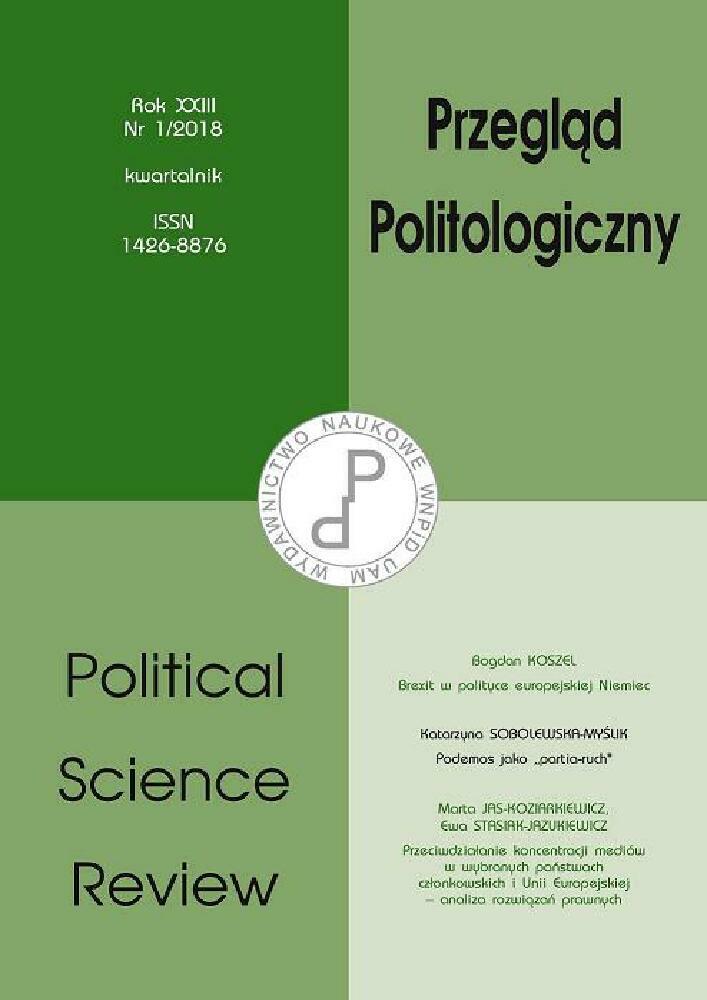Abstract
The modification process of the European Union’s institutional order appears to be permanent. One of the elements of this tendency is the position of the European Council, which is especially interesting in the field of stimulating external EU activities. The aim of this analysis is to explore the EC’s engagement in initiating foreign relations, taking the eastern neighborhood as an example. The paper reviews the European Council’s meetings in the period of 2008–2016, concluding that the EC actively responded to external challenges and created a political impetus for the actions of other institutions. The internal debate initiated by the member states from Central and Eastern Europe resulted in the formulation of the Eastern Partnership initiative that the European Council approved and adopted, giving it a political impetus within the European Union. This caused a specific reaction in the neighborhood. The process of association of some eastern partners was accompanied by the need to deal with the challenging response from Russia, which resorted, among other things, to military measures. The European Council’s involvement in external actions in the East became a self-deepening process with a changing profile and priorities.
References
Alexandrova P., Carammia M., Timmermans A. (2014), EU high politics: the policy agenda of the European Council, 1975–2011, in: The European Council and European Governance. The commanding heights of the EU, eds. F. Foret, Y-S. Rittelmeyer, London–New York.
Doidge M. (2011), The European union and Interregionalism. Patterns of Engagement, Furnham–Burlington.
EC 2008a, European Council 19/20 JUNE 2008 Brussels, 17 July 2008, 11018/1/08, REV 1, CONCL 2.
EC 2008b, European Council 1 SEPTEMBER Brussels, 6 October 2008 (07.10), (OR. fr), 12594/2/08, REV 2, CONCL 3.
EC 2009a, European Council 19/20 MARCH Brussels, 20 March 2009, 7880/09, CONCL 1.
EC 2009b, European Council 18/19 JUNE Brussels, 10 July 2009, 11225/2/09, REV 2, CONCL 2.
EC 2009c, European Council 11/13 DECEMBER Brussels, 5 February 2010, EUCO 6/1/09, REV 1, COEUR 6, CONCL 4.
EC 2010, European Council 16 SEPTEMBER Brussels, 12 October 2010, EUCO 21/1/10, REV 1, CO EUR 16, CONCL 3.
EC 2011a, European Council 4 FEBRUARY Brussels, 8 March 2011, EUCO 2/1/11, REV 1, CO EUR 2, CONCL 1.
EC 2011b, European Council 23 OCTOBER Brussels, 23 October 2011, EUCO 52/11, CO EUR 17, CONCL 5.
EC 2012, European Council 1/2 MARCH Brussels, 28 March 2012, EUCO 4/1/12, REV 1, CO EUR 2, CONCL 1.
EC 2013a, European Council 24/25 OCTOBER 2013 Brussels, 25 October 2013, EUCO 169/13, CO EUR 13, CONCL 7.
EC 2013b, European Council 19/20 DECEMBER 2013 Conclusions, Brussels, 20 December 2013, EUCO 217/13, CO EUR 15, CONCL 8.
EC 2014a, European Council 20/21 March 2014 Conclusions, Brussels, 21 March 2014, EUCO 7/14, CO EUR 2, CONCL 1.
EC 2014b, European Council 26/27 JUNE 2014 Conclusions, Brussels, 27 June 2014, EUCO 79/14, CO EUR 4, CONCL 2.
EC 2014c, European Council 16 JULY 2014 Conclusions, Brussels, 16 July 2014, (OR. en), EUCO 147/14, CO EUR 9, CONCL 3.
EC 2014d, European Council 30 AUGUST 2014 Conclusions, Brussels, 30 August 2014, (OR. en), EUCO 163/14, CO EUR 11, CONCL 4.
EC 2014e, European Council 23/24 OCTOBER 2014 Conclusions, Brussels, 24 October 2014, EUCO 169/14, CO EUR 13, CONCL 5.
EC 2014f, European Council 18 DECEMBER 2014 Conclusions, Brussels 18 December, EUCO 237/14, CO EUR 16, CONCL 6.
EC 2015, European Council meeting (19 and 20 March 2015) – Conclusions, Brussels, 20 March 2015, EUCO 11/15, CO EUR 1, CONCL 1.
EC 2016a, European Council meeting (28 June 2016) – Conclusions, Brussels, 28 June 2016, EUCO 26/16, CO EUR 5, CONCL 3.
EC 2016b, European Council meeting (20 and 21 October 2016) – Conclusions, Brussels, 21 October 2016, EUCO 31/16, CO EUR 8, CONCL 4.
EC 2016c, European Council meeting (15 December 2016) – Conclusions, Brussels, 15 December 2016, EUCO 34/16, CO EUR 10, CONCL 5.
Latosińska A. (2016), Ukraina w polityce zagranicznej Polski (2004–2014), in: Polityka zagraniczna Polski. 25 lat doświadczeń, eds. M. Pietrasiak, M. Stelmach, K. Żakowski, Łódź.
Milczarek D., Zajączkowski K. (2015), Potęga i niemoc. Unia Europejska jako aktor w stosunkach międzynarodowych (część 1), “Studia Europejskie”, no. 1.
Nichol J. (2009), Russia-Georgia Conflict in August 2008: Context and Implications for the US Interests, Congressional Research Service, March 3.
Piskorska B. (2009), Wymiar wschodni Unii Europejskiej – komplementarny czy konkurencyjny dla pozostałych kierunków polityki zagranicznej Unii?, „Środkowoeuropejskie Studia Polityczne”, no. 1–2.
Przybylska-Maszner B., Rewizorski M. (2012), System instytucjonalny Unii Europejskiej po traktacie z Lizbony. Aspekty polityczne i prawne, Warszawa.
Rewizorski M. (2013), Zasady systemu instytucjonalnego Unii Europejskiej, “Studia Europejskie”, no. 1.
Rittelmeyer Y-S. (2014), The institutional consecration of the European Council: symbolism beyond formal texts, in: The European Council and European Governance. The commanding heights of the EU, eds. F. Foret, Y-S. Rittelmeyer, London–New York.
Tallberg J. (2008), Bargaining Power in the European Council, “Journal of Common Market Studies”, vol. 46, no. 3.
Werts J. (2008), The European Council, London.
Wessels W. (2016), The European Council, London–New York.
